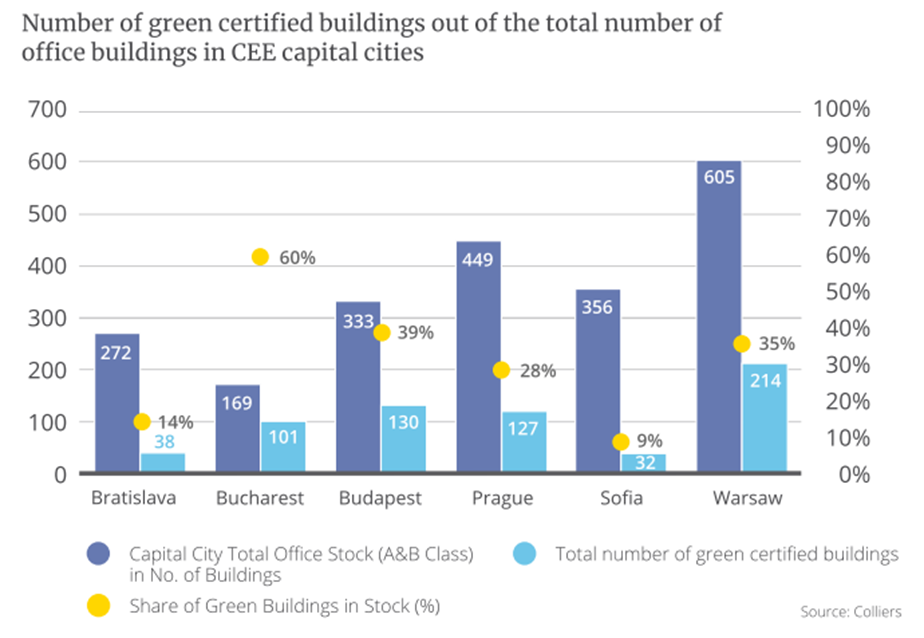
19. 6. 2023
Prague has a lot of catching up to do in the field of green office buildings
When we look at buildings included in the modern office stock (Class A and Class B buildings) in terms of BREEAM, LEED, EDGE and DGNB green certifications, Bucharest has the largest share of certified buildings (60%). Budapest (39%) and Warsaw (35%) follow with a considerably lower margin, with Prague in fourth place (28%) and Bratislava (14%) and Sofia (9%) bringing in the rear. Prague has a lot of catching up to do. However, in absolute terms, the Czech capital is slightly better off with 127 green buildings; only third in the region behind Warsaw with 214 and Budapest with 130.
Although these figures do not look very flattering at the moment, the good news is that the remedy, i.e. bringing the office stock into line with green standards, may not require as much effort in our region as, for example, in Western Europe, where a large proportion of office buildings are much older than here. Another positive aspect is that, on average, three quarters of the newest buildings completed between 2017 and last year have already achieved certification or are in the process of achieving it.
The most widely used certifications in our region are BREEAM and LEED. BREEAM is the most preferred in Warsaw (78% of certified buildings), Budapest (74%), Bratislava (68%), and Prague (58%). The exception is Sofia, where approximately 60% of office buildings are LEED certified. Meanwhile, in Bucharest there is a roughly balanced ratio between BREEAM and LEED. Neither EDGE nor DGNB certifications have yet become widespread in the region; for example, not a single building in Warsaw, Budapest or Bratislava has one of these certifications.
How do BREEAM, LEED, DGNB and EDGE differ from each other? In all cases, they are international standards for assessing the sustainability of buildings. While BREEAM and LEED are generally considered the most well-known ways of assessing building sustainability, DGNB and EDGE are more oriented towards Europe and emerging markets.
BREEAM - Building Research Establishment Environmental Assessment Method
BREEAM is a building sustainability assessment system developed in 1990 in the UK and used primarily in Europe, Asia and Australia. BREEAM assesses the sustainability of buildings in five areas: management, health and well-being, energy, water and materials. It focuses on energy efficiency, water use, indoor environmental quality, materials used and relationship with the environment.
LEED - Leadership in Energy and Environmental Design
LEED is a building sustainability rating system developed in the USA. LEED assesses the sustainability of buildings in areas such as energy, water, materials, relationship with the environment and indoor environment. It focuses on energy efficiency, water use, indoor environmental quality and materials used.
DGNB - Deutsche Gesellschaft für Nachhaltiges Bauen
DGNB is a standard for assessing the sustainability of buildings developed in Germany. DGNB focuses on the environmental, social and economic aspects of building sustainability and assesses a building’s overall sustainability, while including aspects such as energy efficiency, water use, indoor environmental quality and transport.
EDGE - Excellence in Design for Greater Efficiencies
EDGE is a more recent building sustainability assessment developed by the IFC (International Finance Corporation), part of the World Bank. EDGE assesses energy efficiency, water use and energy performance and focuses on low- and middle-income markets.

The Prague office market is currently dominated by BREEAM certification: 74 buildings have this certificate, whether New or In Use. In contrast, 53 buildings are LEED certified at various levels. However, we see an interesting trend where virtually all buildings under construction in Prague are targeting LEED certification and only one building is seeking BREEAM certification. There is a clear shift towards the American certification methodology, which is focused on energy management and innovation in building management combined with a friendly approach to the surrounding area and community.
